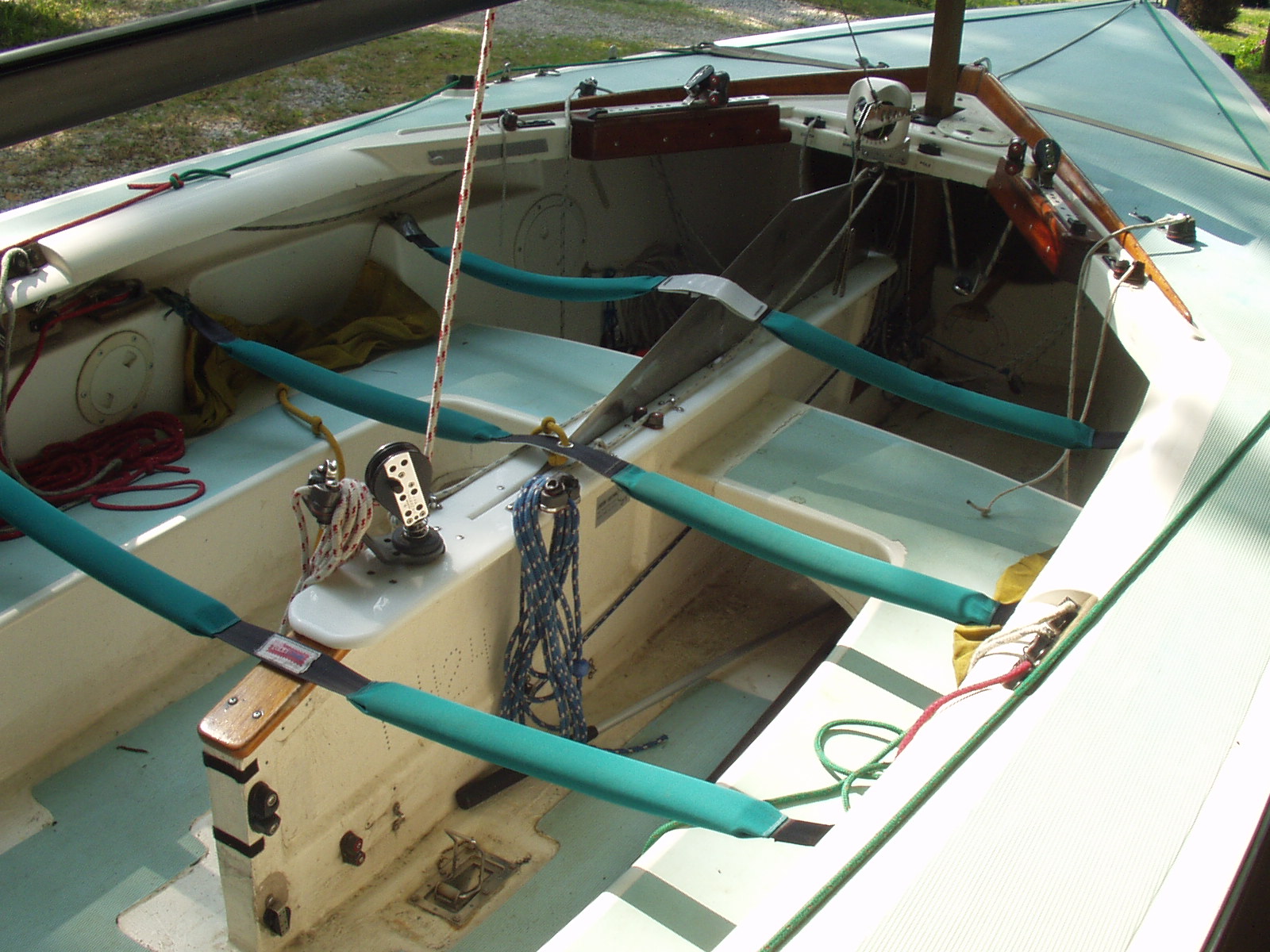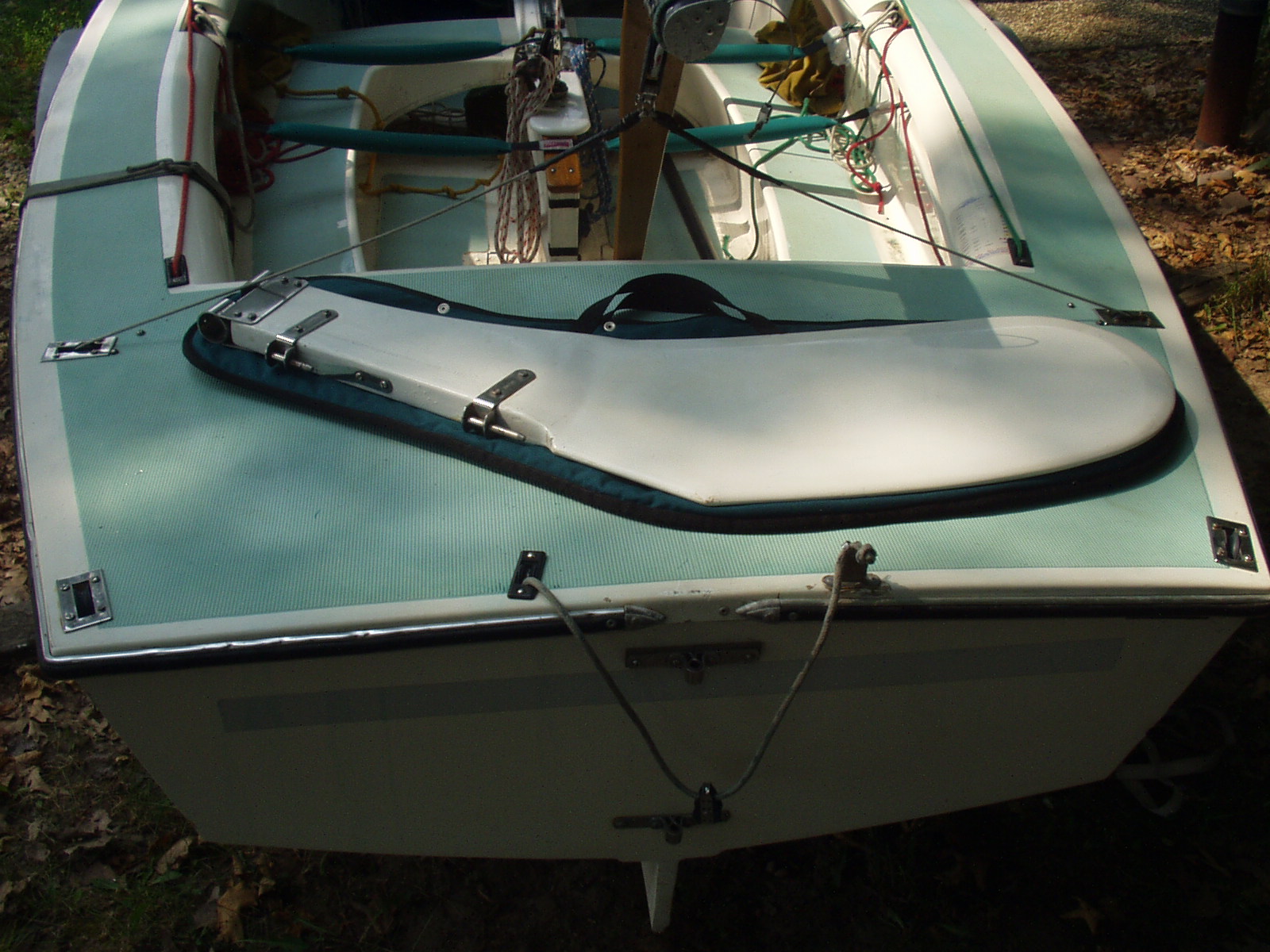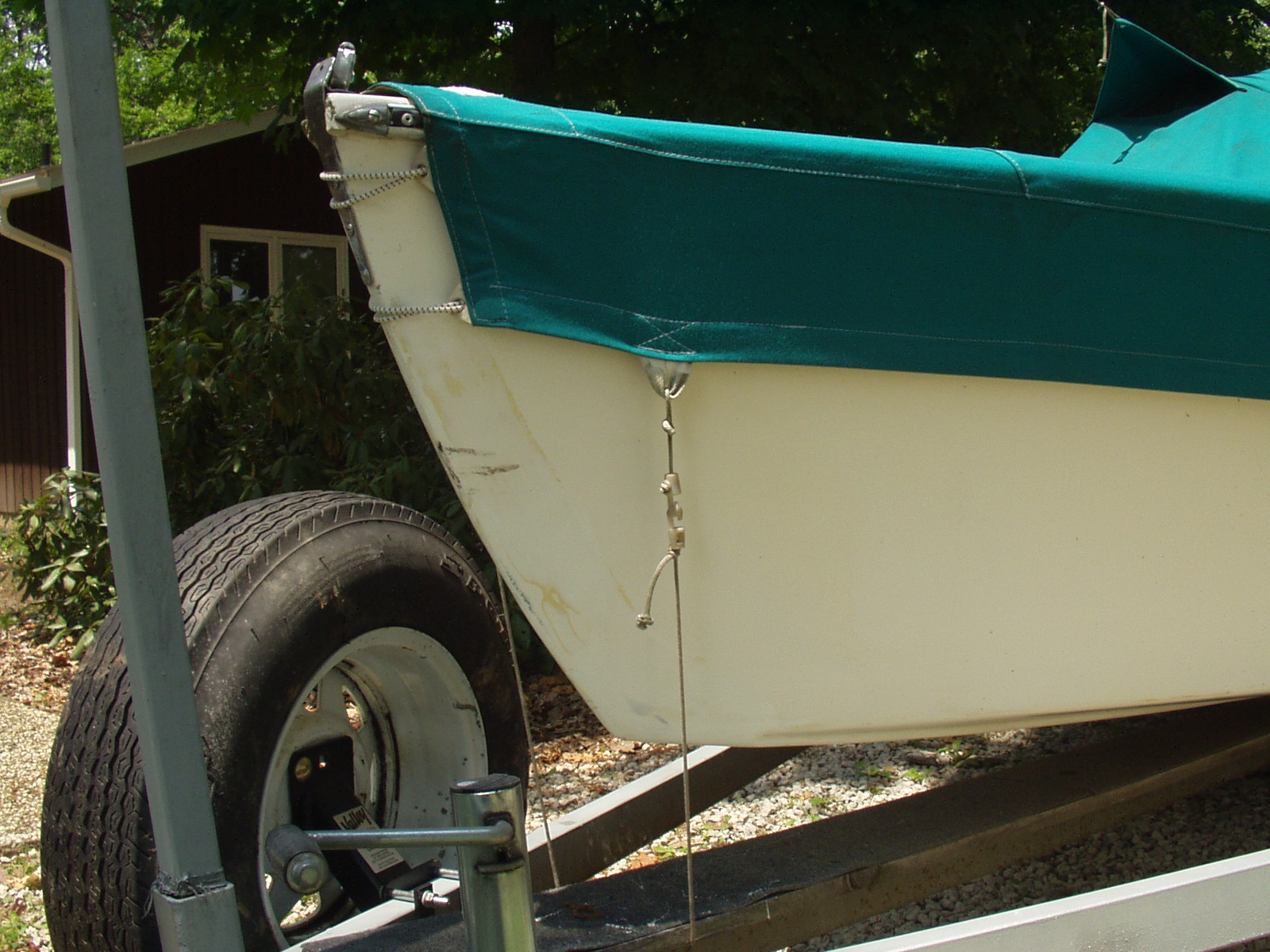
Lightning 14424
General

Built 1990 by Jim Carson (Fuzzy Specialties). Jim is a former Class president and chief measurer.
The Carson boats were built originally using the old Lippincott molds and slightly modified over
the years. This is the last boat Jim built for himself. If you would like more info on the Carson
boats you can call Jim at 732-892-1924 or email at jgcfuzzy@comcast.net. Boat is all fiberglass
except for the splashrail and parts of the the centerboard trunk cap, which are mahogany. The mahogany top of the centerboard cap has just been replaced with a piece of white hdpe plastic made in a very similar configuration to the original. See photos below.
I bought this from Jim Carson in 1995 and have raced it extensively since then, mostly in regattas
around Ohio. It has always been drysailed and has a measurement certificate.
It was last weighed (I think) in the 1999 Ohio Districts. Usually weighs in at about 708. It has no
corrector weights.
Everything on the boat works and works easily.
Hull
Overall, the hull is in good shape, but has some small nicks and scratches..
Has no known structural damage.
Bottom is fair. I faired the bottom a few years back and added new gelcoat which was sanded and polished. There are some minor scratches on the bottom, however.
The boat was originally sailed in salt water, but I have only sailed it in fresh water.
This boat has NO floorboards. Some explanation is needed here. Carson boats are made with side tanks and a bow tank. The floor is the bottom of the boat - ie: no false bottom. The idea here is to minimize the tendency to turtle. As a result, this boat has more leg room than any other kind of Lightning.
It has the original rub rail which is aluminum with a vinyl(?) insert. It's a very tough rubrail.
Sails and Covers
Main - 1994 North - getting pretty old, but serviceable.
Jibs - One Sobstad and two Norths (around 1994-1995)
Spinnakers - One North and one Sobstad. Getting a little tired, but still raceable. I still use them for retattas.
Mooring Cover - 1995 Fabricraft - ½ sides, needs a good cleaning. Also Fabricraft padded
rudder cover and mast butt cover. All teal color.
Rigging
Definitely Race Rigged: Suunto Compass, Mostly Harken blocks and cleats. Dual side controls for vang (on forward deck), cunningham, outhaul, traveler, and backstay. Jib uphaul (wire) and cloth are on the dashboard. Nickels jib car setup, moved inward to class limits on mahogany blocks. Nickels rudder with tube tiller. Set up for second tiller extension should the rubber universal break (it never has, by the way).
Stainless board with preventer/pull-down for board. A Jim Carson special setup. You can pull the board down under load with this.
The mast and boom are Bryant and probably original to the boat. They are very stiff. Mainsheet is internal -+**to the boom.
Spinnaker pole has RWO ends (snaps over pole bales very easily).
Trailer
1982 Concord trailer. I never heard of them either. Looks kind of like a Nickels trailer, but
painted, and with a (new in 1998) 3500 Lb. drop axle and big fenders over 14" tires. The spare tire
is mounted on a carrier at the front of the trailer. Rims are white painted spoke type. Axle has a type of bearing
buddies. Lights are mounted on trailer. Use standard 4-prong connector. Tall mast pole at front
of trailer will easily clear the top of a standard sized van. Rear end of mast sits on a throw cushion
and is bungied to the rudder gudgeons during trailering. Trailer tows very well and is quite low,
similar to an Allen trailer, but with a longer tongue. Also has wide padded bunks to minimize
bottom dents over time.
Extras
On-e wooden paddle is included, older but but serviceable. Anchor: boat wold go with either a galvanized Danforth type or a folding 3- Lb. grapnel type anchor with about 75' of 3/8 line on it. (The class minimum is 4.0 Lb for racing.)

This shows the boat on the trailer with the spare tire, front jackstand, and a temporary mast to support the cover.

This shows the starboard forward area of the cockpit. The compass was new in 2004. The cleat on the foredeck is for the vang. The one at the end of the splashrail is for the barber haul. Note that the jib cleats are vertical, and set inboard to the class limit on a pair of mahogany blocks.

This shows the forward area of the cockpit. The jib wire, jib cloth, and pole controls are on "dashboard".

This shows the cockpit area with a good view of the new plastic centerboard trunk cap. It also shows the Fabricraft hiking straps, the 3" ratchet block for the main sheet, and the universal mounted centerboard cleat (with the blue line).

This shows the three double-ended controls on each side. They control the Cunningham, the bridle side-to-side, and the backstay. The small block at the bottom right of the photo shows the end of the preventer, with a loop in the line to allow you to pull the centerboard down under load. Did you ever get to the leeward mark, start to head upwind , and find yourself sliding sideways?

This shows the aft deck with the Nickels rudder, and Fabricraft rudder cover. The horizontal band on the transom is reflective tape for high visibility when trailering at night without a trailering cover. It also shows a second set of rear spinnaker sheet blocks. I prefer this more forward position for these blocks to keep the spinnaker sheet from hooking over the end of the boom. If you've ever had that happen, you know how stressful it can be! The bridle is a Spectra (I believe) line. It can pull the boom to windward if necessary, if the side-to-side control is on the other side. There is no height control on this line.

This is the boat name that I have used. The same graphic is on both sides. It's a vinyl stick-on thing, so you can easily remove it and call it whatever you want.

This is a "warts and all" shot. It shows where the bow needs a bit of new gellcoat. It has been sanded through a bit. The black marks are just dock marks from a recent regatta and will come right off.

This shows some details of the front of the trailer. The safety chains are heavier than normal for additional safety. There is a caster wheel both on the trailer tongue and the lift jack. They both work. There is also a carpeted plank which goes all the way to the forward trailer bunk to facilitate ramp launching. The grey coating on on the trailer is cold galvanizing and/or silver rustoleum.

This shows the boat with the Fabricraft cover in place (held up by a temporary mast supporting the boom). It could stand a bit of cleaning, but is serviceable. There is a patch (same material as the cover) near the end of the boom where a small rodent ate through it one looking for food. The lesson here is: Don't put your cover on top of the can containing your squirrel corn.